Leadership Styles in Orgnistaion
88 Pages21566 Words63 Views
Added on 2021-06-17
Leadership Styles in Orgnistaion
Added on 2021-06-17
ShareRelated Documents
Running head: LEADERSHIP STYLES IN ORGANIZATIONS
Leadership Styles in Organizations
Name of the Student
Name of the University
Author Note
Leadership Styles in Organizations
Name of the Student
Name of the University
Author Note
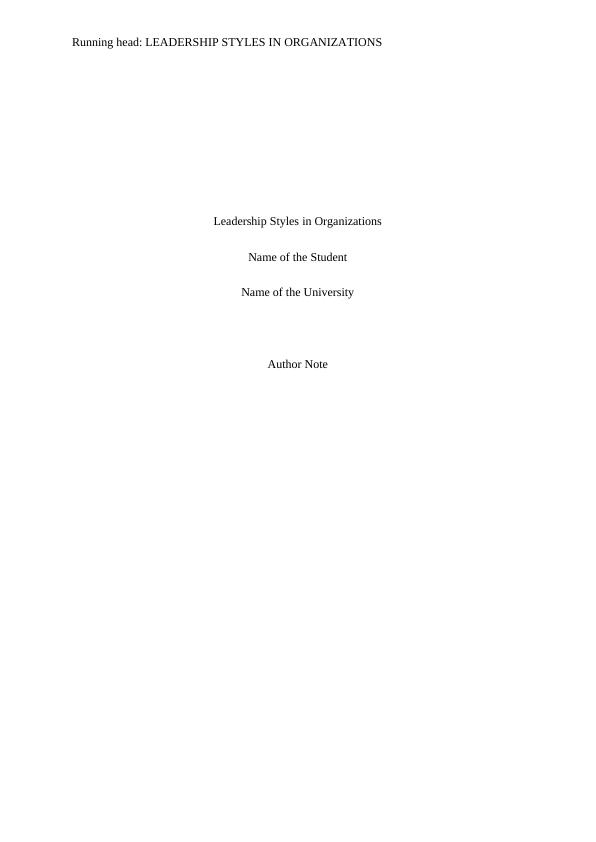
LEADERSHIP STYLES IN ORGANIZATIONS1
Acknowledgement:
I like to thanks my professor my family and friends, who support me to do this research work
efficiently through providing me proper guidance and support. Without their cooperation, it
would be difficult for me to conduct the entire analysis. For preparing the assignments, I had
taken help and guidance from the respected persons who deserves my deepest gratitude. I
would also like to show my gratitude to my professors for completing my assignments who
directly and indirectly guided me in writing this assignments.
Acknowledgement:
I like to thanks my professor my family and friends, who support me to do this research work
efficiently through providing me proper guidance and support. Without their cooperation, it
would be difficult for me to conduct the entire analysis. For preparing the assignments, I had
taken help and guidance from the respected persons who deserves my deepest gratitude. I
would also like to show my gratitude to my professors for completing my assignments who
directly and indirectly guided me in writing this assignments.

LEADERSHIP STYLES IN ORGANIZATIONS2
Abstract:
The global commercial and organizational framework had undergone considerable changes
and dynamics over the last few decades, owing to international phenomena of immense
significance. In this context, with the increasing dynamics in the commercial operational
framework, the concept of leadership in the business organizations has also evolved
significantly, with the importance of the same being rising among the participants of the
global business environment. The presence of a good leadership leads to creation of morale
and inspiration for the employees, thereby motivating them to perform better. There are
different leadership styles, recognised in the contemporary business framework, of which the
increasingly popular styles are those of transactional and transformational styles. The study
tries to analyse which form of leadership, between transactional and transformational, is more
relevant and effective for HtooGroup of Companies. The survey analysis considers MLQ-5X
and comes to know that transactional leaders impact more on employees in this company
compare to transformational leaders.
Abstract:
The global commercial and organizational framework had undergone considerable changes
and dynamics over the last few decades, owing to international phenomena of immense
significance. In this context, with the increasing dynamics in the commercial operational
framework, the concept of leadership in the business organizations has also evolved
significantly, with the importance of the same being rising among the participants of the
global business environment. The presence of a good leadership leads to creation of morale
and inspiration for the employees, thereby motivating them to perform better. There are
different leadership styles, recognised in the contemporary business framework, of which the
increasingly popular styles are those of transactional and transformational styles. The study
tries to analyse which form of leadership, between transactional and transformational, is more
relevant and effective for HtooGroup of Companies. The survey analysis considers MLQ-5X
and comes to know that transactional leaders impact more on employees in this company
compare to transformational leaders.
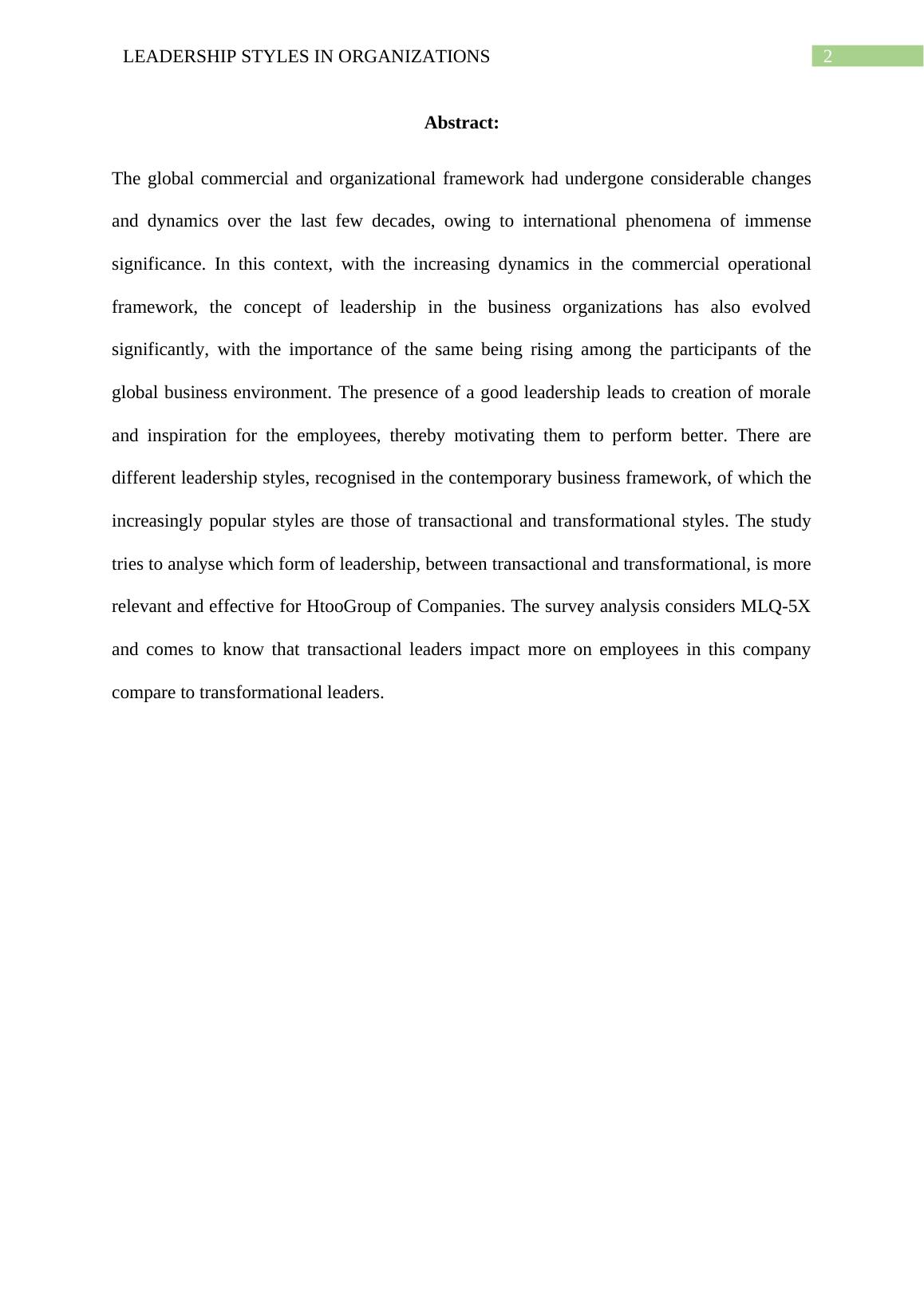
LEADERSHIP STYLES IN ORGANIZATIONS3
Table of Contents
Chapter 1: INTRODUCTION....................................................................................................6
1.1 Introduction......................................................................................................................6
1.2 Research Background.......................................................................................................7
1.3 Significance of the Research............................................................................................9
1.4 Research Aims...............................................................................................................10
1.5 Research Objectives.......................................................................................................11
1.6 Research Questions........................................................................................................11
1.7 Research Hypothesis:.....................................................................................................12
1.8 Research Structure.........................................................................................................12
CHAPTER 2: LITERATURE REVIEW.................................................................................15
2.1 Introduction........................................................................................................................15
2.2 Significance of leadership in an organization....................................................................15
2.3 Overview of the transformational leadership and transactional leadership style...............18
2.4 Determination of which leadership style is better relating to the HGC employees job
performance and satisfaction....................................................................................................22
2.5 Importance of job satisfaction:...........................................................................................26
2.6 Transformational and transactional leadership style applied by HGC leaders on their
employee’s job satisfaction:.....................................................................................................28
2.7 Significance of job performance:.......................................................................................29
2.8 Impact of transformational as well as transactional leadership style used by HGC leaders
regarding job performance of employees:................................................................................32
Table of Contents
Chapter 1: INTRODUCTION....................................................................................................6
1.1 Introduction......................................................................................................................6
1.2 Research Background.......................................................................................................7
1.3 Significance of the Research............................................................................................9
1.4 Research Aims...............................................................................................................10
1.5 Research Objectives.......................................................................................................11
1.6 Research Questions........................................................................................................11
1.7 Research Hypothesis:.....................................................................................................12
1.8 Research Structure.........................................................................................................12
CHAPTER 2: LITERATURE REVIEW.................................................................................15
2.1 Introduction........................................................................................................................15
2.2 Significance of leadership in an organization....................................................................15
2.3 Overview of the transformational leadership and transactional leadership style...............18
2.4 Determination of which leadership style is better relating to the HGC employees job
performance and satisfaction....................................................................................................22
2.5 Importance of job satisfaction:...........................................................................................26
2.6 Transformational and transactional leadership style applied by HGC leaders on their
employee’s job satisfaction:.....................................................................................................28
2.7 Significance of job performance:.......................................................................................29
2.8 Impact of transformational as well as transactional leadership style used by HGC leaders
regarding job performance of employees:................................................................................32

LEADERSHIP STYLES IN ORGANIZATIONS4
2.9 Relation between transformational leadership and satisfaction of leaders with job
performance and leader in HGC:.............................................................................................34
Chapter 3: REASERCH METHEDOLOGY...........................................................................36
3.1 Introduction:...................................................................................................................36
3.2 Method Outline:.............................................................................................................36
3.3 Research Onion:.............................................................................................................37
3.4 Research Philosophy:.....................................................................................................37
3.5 Research Approach:.......................................................................................................38
3.6 Research Design:............................................................................................................38
3.7 Data Collection:.............................................................................................................39
3.8 Sampling Method and Sample Size:..............................................................................40
3.9 Data Analysis Plan:........................................................................................................41
3.10 Ethical Consideration:..................................................................................................41
3.11 Research validation along with data reliability:...........................................................42
3.12 Limitation of the study:................................................................................................42
3.13 Time Frame:.................................................................................................................42
3.14 Chapter Summary:.......................................................................................................43
Chapter 4: RESULTS AND DISCUSSION............................................................................45
4.1 Introduction:.......................................................................................................................45
4.2 Socio-Demographic Analysis of all respondents:..........................................................45
4.3 Reliability Test:..............................................................................................................48
4.4 Descriptive Statistics:.....................................................................................................49
2.9 Relation between transformational leadership and satisfaction of leaders with job
performance and leader in HGC:.............................................................................................34
Chapter 3: REASERCH METHEDOLOGY...........................................................................36
3.1 Introduction:...................................................................................................................36
3.2 Method Outline:.............................................................................................................36
3.3 Research Onion:.............................................................................................................37
3.4 Research Philosophy:.....................................................................................................37
3.5 Research Approach:.......................................................................................................38
3.6 Research Design:............................................................................................................38
3.7 Data Collection:.............................................................................................................39
3.8 Sampling Method and Sample Size:..............................................................................40
3.9 Data Analysis Plan:........................................................................................................41
3.10 Ethical Consideration:..................................................................................................41
3.11 Research validation along with data reliability:...........................................................42
3.12 Limitation of the study:................................................................................................42
3.13 Time Frame:.................................................................................................................42
3.14 Chapter Summary:.......................................................................................................43
Chapter 4: RESULTS AND DISCUSSION............................................................................45
4.1 Introduction:.......................................................................................................................45
4.2 Socio-Demographic Analysis of all respondents:..........................................................45
4.3 Reliability Test:..............................................................................................................48
4.4 Descriptive Statistics:.....................................................................................................49

LEADERSHIP STYLES IN ORGANIZATIONS5
4.5 Correlation Analysis:.....................................................................................................50
4.6 Inferential Statistics:.......................................................................................................53
4.7 Discussion:.....................................................................................................................57
Chapter 5: CONCLUSIONS AND RECOMMENDATIONS.................................................62
5.1: Conclusion:...................................................................................................................62
5.2 Recommendations:.........................................................................................................65
References................................................................................................................................67
Appendix..................................................................................................................................76
Questionnaire...........................................................................................................................76
4.5 Correlation Analysis:.....................................................................................................50
4.6 Inferential Statistics:.......................................................................................................53
4.7 Discussion:.....................................................................................................................57
Chapter 5: CONCLUSIONS AND RECOMMENDATIONS.................................................62
5.1: Conclusion:...................................................................................................................62
5.2 Recommendations:.........................................................................................................65
References................................................................................................................................67
Appendix..................................................................................................................................76
Questionnaire...........................................................................................................................76
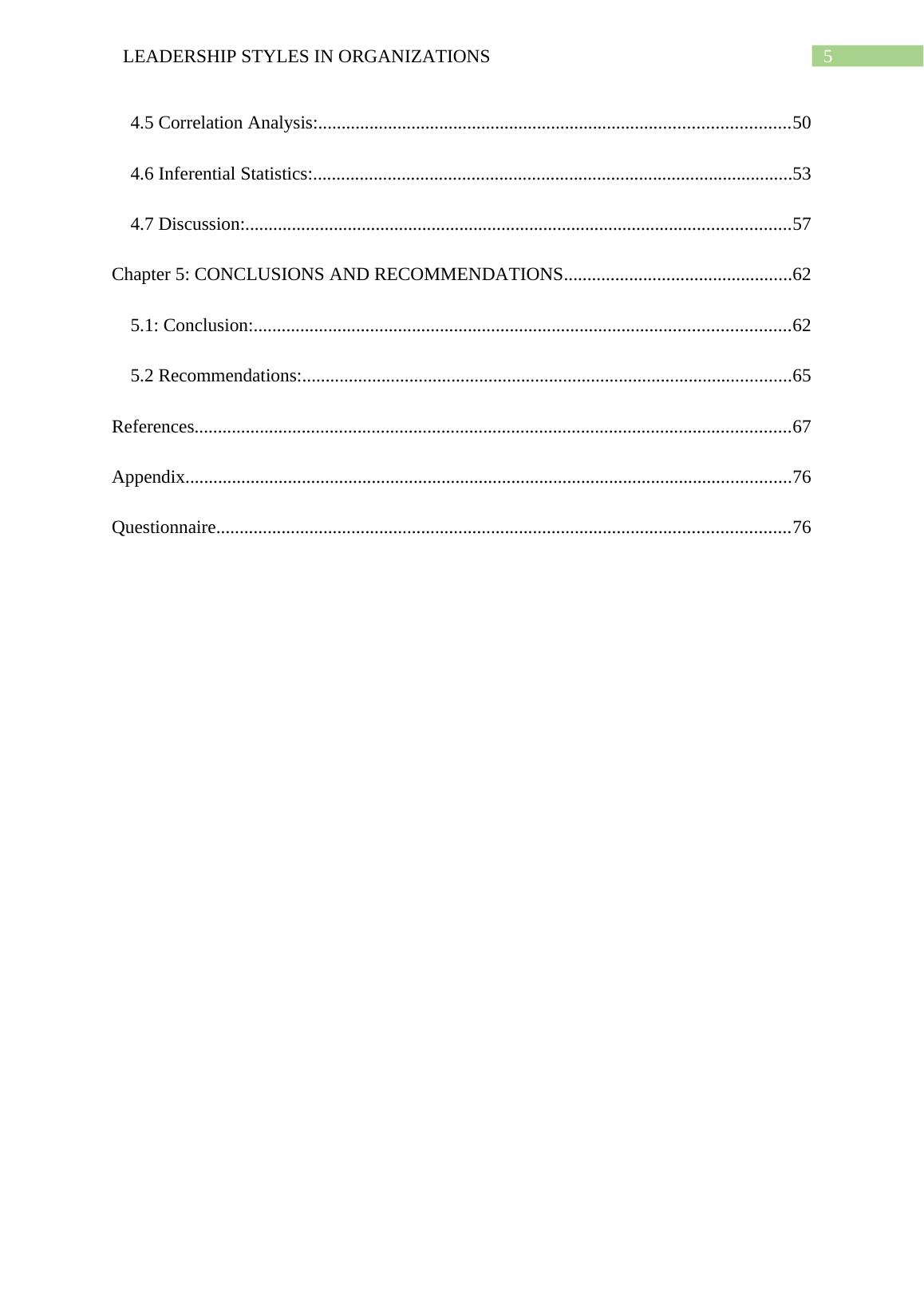
LEADERSHIP STYLES IN ORGANIZATIONS6
Chapter 1: INTRODUCTION
1.1 Introduction
The global commercial and organizational framework had undergone considerable
changes and dynamics over the last few decades, owing to international phenomena of
immense significance like that of Globalisation, liberalisation of trade and commerce and
technological and infrastructural framework (Ferraroand Briody2013). All these factors have
cumulatively contributed in making business and organizational scenario more global,
integrated and inclusive and interconnected (Jankalová2012).
In this context, with the increasing dynamics in the commercial operational
framework, the concept of leadership in the business organizations has also evolved
significantly, with the importance of the same being rising among the participants of the
global business environment (Wibbekeand McArthur2013). Leaders, in businesses, are
usually those who encourage and persuade their team members to work in such a way that the
organization targets and goals are reached within specified times and the welfare of all the
participants of the organizations are also maximised (Raeet al. 2012). Over the years, owing
to dynamics in the global commercial environment, the notion of leadership in business has
also become increasingly complex and different types of leadership structures and styles have
also evolved in this aspect, depending upon the needs of the situations (Birdand
Mendenhall2016). This is primarily because of the varied and multilateral impacts of the
presence of an efficient leadership structure in an organization. As highlighted by Yıldız,
Baştürkand Boz (2014), the presence of a good leadership leads to creation of morale and
inspiration for the employees, thereby motivating them to perform better. Robust leadership
structure also encourages free flow of ideas and organization of operations and strategic
implementations, together which leads to higher profitability and better reputation of the
Chapter 1: INTRODUCTION
1.1 Introduction
The global commercial and organizational framework had undergone considerable
changes and dynamics over the last few decades, owing to international phenomena of
immense significance like that of Globalisation, liberalisation of trade and commerce and
technological and infrastructural framework (Ferraroand Briody2013). All these factors have
cumulatively contributed in making business and organizational scenario more global,
integrated and inclusive and interconnected (Jankalová2012).
In this context, with the increasing dynamics in the commercial operational
framework, the concept of leadership in the business organizations has also evolved
significantly, with the importance of the same being rising among the participants of the
global business environment (Wibbekeand McArthur2013). Leaders, in businesses, are
usually those who encourage and persuade their team members to work in such a way that the
organization targets and goals are reached within specified times and the welfare of all the
participants of the organizations are also maximised (Raeet al. 2012). Over the years, owing
to dynamics in the global commercial environment, the notion of leadership in business has
also become increasingly complex and different types of leadership structures and styles have
also evolved in this aspect, depending upon the needs of the situations (Birdand
Mendenhall2016). This is primarily because of the varied and multilateral impacts of the
presence of an efficient leadership structure in an organization. As highlighted by Yıldız,
Baştürkand Boz (2014), the presence of a good leadership leads to creation of morale and
inspiration for the employees, thereby motivating them to perform better. Robust leadership
structure also encourages free flow of ideas and organization of operations and strategic
implementations, together which leads to higher profitability and better reputation of the
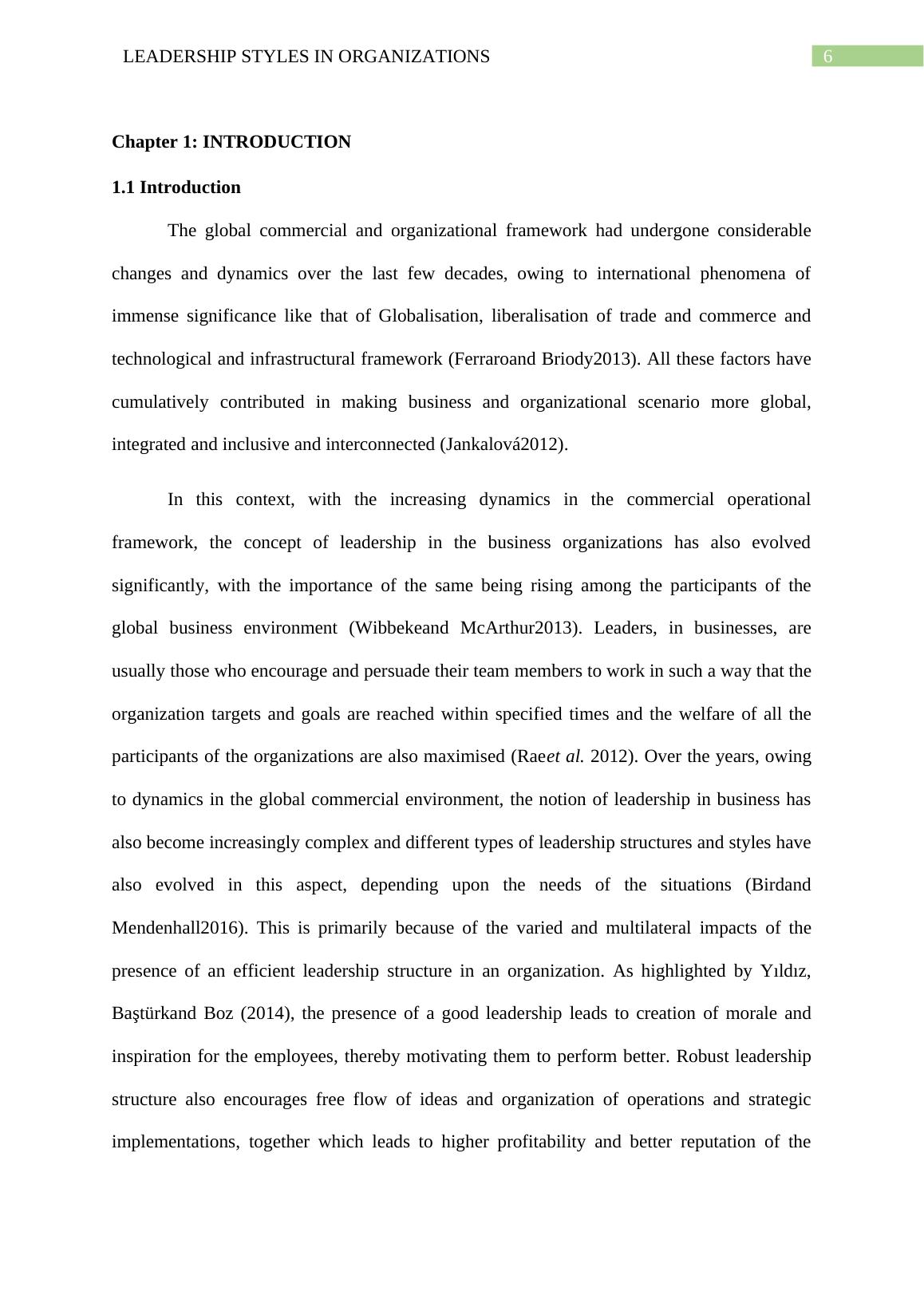
LEADERSHIP STYLES IN ORGANIZATIONS7
organizations. There are different leadership styles, recognised in the contemporary business
framework, of which the increasingly popular styles are those of transactional and
transformational styles. While transactional leadership style of leadership focuses on
organization, supervision and performance of the companies, transformational leadership
focuses on working for identification of areas for change and creation of vision for
implementing changes through inspiration from the leader of the organization.
Keeping this into consideration, the concerned research explores the different forms
of leadership, specifically the transactional and transformational forms of leadership, thereby
comparing the attributes and the impacts of the same on the performance, satisfaction of the
employees and the overall performance of the organizations, specifically focussing on the
management operations of the HtooGroup of Companies, a Burmese holding organization
located in Myanmar. The study tries to analyse which form of leadership, between
transactional and transformational, is more relevant and effective for the concerned company.
1.2 Research Background
As discussed above, the Htoo Group of Companies, being a Myanmar holding
company, was established in 1900 and invests in diverse fields like that of construction,
trading, hotels, aviation, resorts, financial services, agriculture, food and beverage as well as
lifestyle and entertainment businesses. With an employee strength of more than 40,000
people, the company currently generates an average revenue of nearly 65 million USD and
has a number of subsidiaries, venturing in different fields of the country (Htoo.com 2018).
All these factors and the overall growth and the long-term sustainability of the concerned
organization depend considerably on the leadership structures of the same and the behaviour
and activities as well as the leadership strategies taken by the leaders in the organization
(Minand Kudo2014).
organizations. There are different leadership styles, recognised in the contemporary business
framework, of which the increasingly popular styles are those of transactional and
transformational styles. While transactional leadership style of leadership focuses on
organization, supervision and performance of the companies, transformational leadership
focuses on working for identification of areas for change and creation of vision for
implementing changes through inspiration from the leader of the organization.
Keeping this into consideration, the concerned research explores the different forms
of leadership, specifically the transactional and transformational forms of leadership, thereby
comparing the attributes and the impacts of the same on the performance, satisfaction of the
employees and the overall performance of the organizations, specifically focussing on the
management operations of the HtooGroup of Companies, a Burmese holding organization
located in Myanmar. The study tries to analyse which form of leadership, between
transactional and transformational, is more relevant and effective for the concerned company.
1.2 Research Background
As discussed above, the Htoo Group of Companies, being a Myanmar holding
company, was established in 1900 and invests in diverse fields like that of construction,
trading, hotels, aviation, resorts, financial services, agriculture, food and beverage as well as
lifestyle and entertainment businesses. With an employee strength of more than 40,000
people, the company currently generates an average revenue of nearly 65 million USD and
has a number of subsidiaries, venturing in different fields of the country (Htoo.com 2018).
All these factors and the overall growth and the long-term sustainability of the concerned
organization depend considerably on the leadership structures of the same and the behaviour
and activities as well as the leadership strategies taken by the leaders in the organization
(Minand Kudo2014).
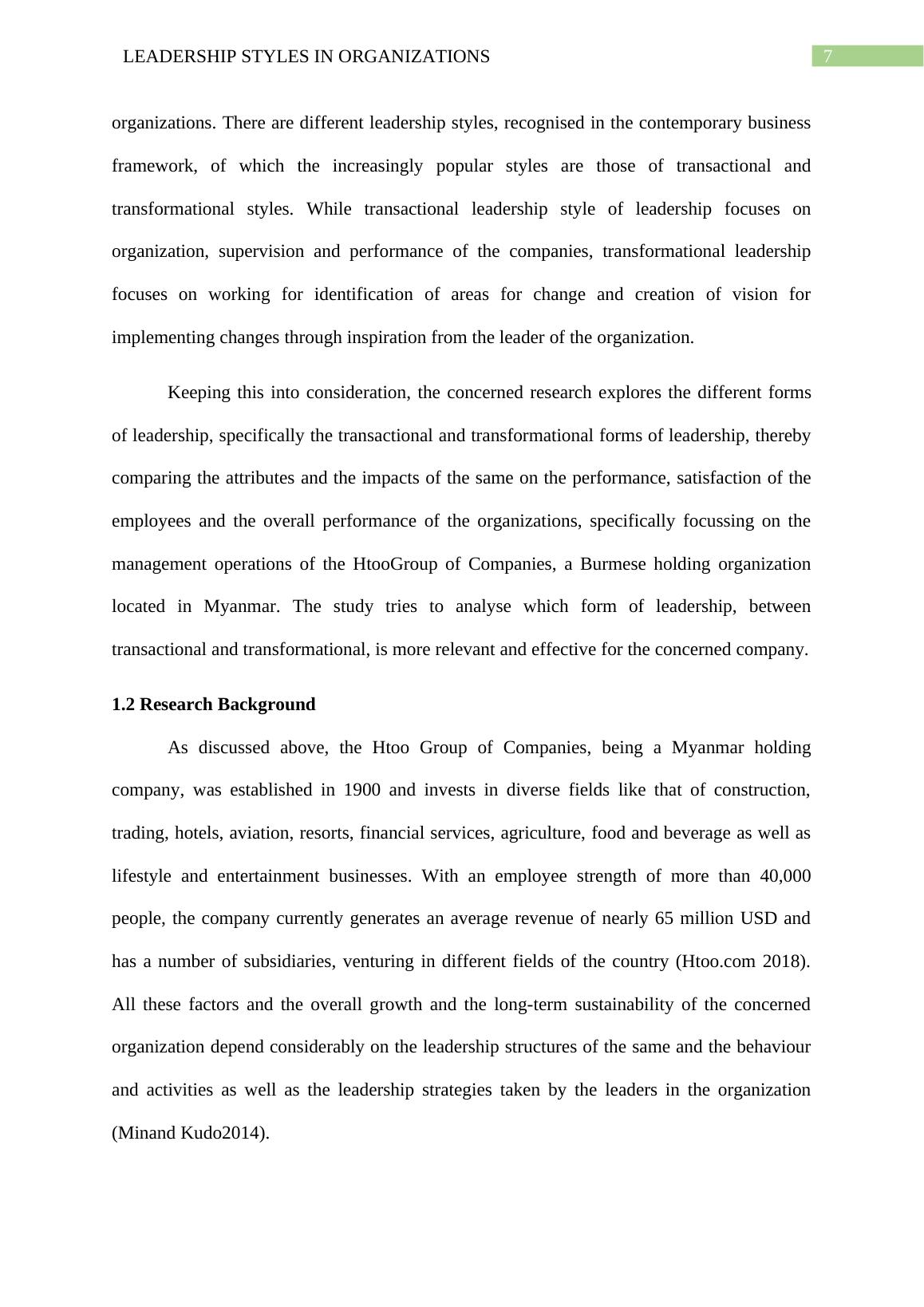
End of preview
Want to access all the pages? Upload your documents or become a member.
Related Documents
Managing International Businesslg...
|69
|20400
|72
Digital Business Models towards More Sustainable Values by Technology and Big Datalg...
|86
|16619
|290
Analyze the leadership qualities required in the constructionlg...
|101
|20074
|5
Leadership Styles: A Literature Reviewlg...
|66
|17585
|170
The Impact of Transformational Leadership on Innovation mediated by Knowledge Sharing Behaviorlg...
|72
|23438
|75
The Impact of Customer Satisfaction and Customer Loyalty - Hotel Industrylg...
|91
|21753
|266
